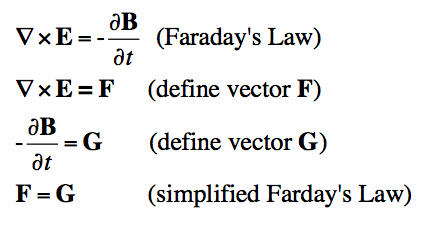The Equals Sign in Faraday's Law
The Equals Sign (=)
The Equals Sign (=) in Equation 3, or Faraday's Law is actually different from the equals signs in the first two (scalar) Maxwell's Equations. In Faraday's Law, the equals sign relates two 3-dimensional vectors on either side. Hence, this equals sign is actually 3 equals signs that relate each of the components of the vectors. To see this clearly, let's rewrite Faraday's law as F = G, where F and G are two 3-dimensional vector fields:
Then the true meaning of the = sign in Farday's Law can be shown in Equation [2] - it means the x-component of the F vector must equal the x-component of the G vector, the y-components must be equal, and teh z-components are equal:
We see from [2] that the vector equals = is equivalent to 3 scalar equals signs. Therefore, while it seems trivial to define the equality signs in Maxwell's Equations, they do have different meanings. The final note about this equals: it relates quantities with units of Volts per meter squared [V/m^2]. It is important to know the units of what you are measuring, so this is not info that should be discarded.
|

